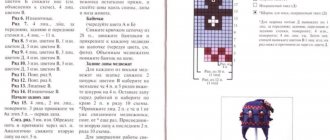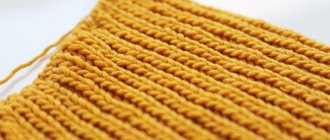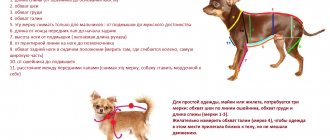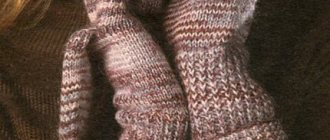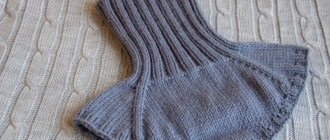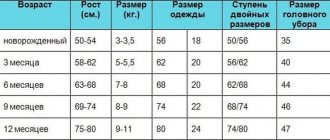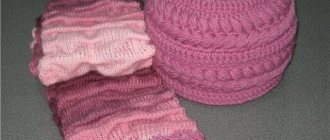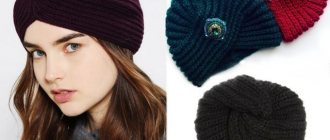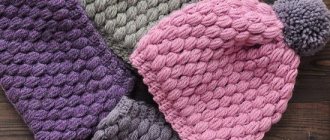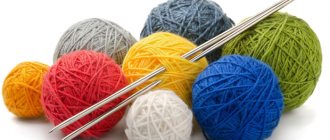general information
Those who are just learning how to independently sew knitted items need to learn the basic instructions regarding working with parts. The finished parts of future clothing must be ironed before sewing. The shoulder seams are sewn first, then the side seams.
Stitched knitted item
Important! You cannot use a long thread when working; the optimal length is 45 centimeters.
Loop-to-loop stitch
The secret line “loop to loop” is performed by beginning craftswomen. It is simple and allows you to qualitatively connect parts of garter and other stitches. A closed knit stitch can be used to sew a pocket or other part to a finished knitted garment. The open method is also often used when assembling material.
Making a seam Loop to loop
Sew two closed edges
The invisible row for closed edges is made similarly to the technology for the face and back. The thread is brought out from the wrong side to the middle of the stitch, after which they cling to the broach of the buttonholes of the second part, and bring the needle into the middle of the front loop from top to bottom.
Important! You should not take a thick tool when working.
Sew the two open edges
To perform inconspicuous stitching, stick the needle in 2 front steps, skip the back ones. The action is repeated on the canvas along the entire length. Then the open material is turned over and the opposite side is sewn. It is important to sew without tightening the thread too much.
You might be interested in: The design of sewing machine pedals, their disassembly and repair
Two open edges
Vertical seams “Mattress seam”
The correct mattress step is made according to the same pattern as a simple knitted step. The knitted parts are placed close to each other, row by row, and be sure to use the same thread used for knitting for stitching. A hat, sleeve or other wardrobe item can be fastened with a mattress seam.
Mattress seam
On the front surface
At the end of knitting, the pieces are ironed and then laid out on the table. The needle is inserted next to the edge and first loop, and the thread is pulled through. On the opposite side, pick up the broach between the loops. Then repeat the steps alternately and tighten the thread.
On purl loops
The loop is performed in the same way. The tool pierces the space between the outer and next loop. Then they stick it between the edge and the next hole. After 3 centimeters, the thread is tightened.
Execution on the front side
For serrated edge
Knitting along a scalloped edge is more difficult, but the algorithm does not change. Using a needle, pass the thread between the edge and the next hole, and also periodically tighten it, observing intervals.
Knitting methods
On circular knitting needles
We cast on the required number of loops. Then there are two ways:
- We connect the product in a circle. We swap the two outer loops, threading one into the other. Next we go with the desired pattern.
- We knit the entire product with canvas and sew it together at the end. This path is relevant if the fabric is really large and does not fit on ordinary knitting needles.
In both cases, do not forget that you need to gradually decrease the loops closer to the top. Usually this is clearly stated in the diagrams.
Joining the initial row on circular knitting needles. Video tutorial:
Garter stitch
We cast on and start knitting in rows: slip off the first stitch and then knit all the way to the last one (it’s purl). Closer to the top, we remove the loops and finally sew the product together using a knitting needle.
In a circle it will be more practical - no need to sew + the hat will have no unnecessary irregularities.
Garter stitch in the round with knitting needles. Video for beginners:
Stockinette stitch
The only difference from the previous point is the structure.
We always remove the first one, always remove the last one. We knit the rows alternately: one - the whole rib, the second - sp.
As a result, you will get two sides - the wrong side and the front side, on which the given pattern is located.
How to knit smooth stockinette stitch - video tutorial:
Hat with 5 spokes
The knitting principle is similar to circular knitting needles. Divide the cast-on loops evenly into 4 parts and distribute them over the knitting needles. It turns out to be a square along which we continuously go upward with the fifth knitting needle in the desired knitting pattern.
Hand stitching
If the yarn requires preparation, the product is ironed and then stitched. The advantage of the seam is that it will not pull the item together. It is important to pass the thread below the closed row. The stitches lead backwards, and the thread is sure not to be damaged.
You may be interested in Using a hidden inner seam with a needle by hand
Important! Periodically you need to turn the part over to the reverse side to monitor the quality of the stitches.
Hand stitching
Kettel seam
A quilt stitch is used to connect the main parts of the product with pockets, trims, and trims. Before starting work, be sure to iron each component. Types of seam:
- needle;
- crochet
Kettel seam
Method one - with a needle
The part is pierced with a needle from the inside at the place of the second step. Then they stick it into the first loop and take it out through the third hole. Then they pass the needle from top to bottom into the second loop and pull it through the fourth hole from bottom to top. The advantage of the product is that it holds its shape for a long time.
Method two - crochet
A needle is not always suitable for the job. Therefore, there is a way to tie with the same seam using a hook. To do this, take a short tool, fold the parts face to face and knit them in a half-stitch.
Crochet work
How to sew knitted items correctly and with what seam
To bookmarks
Before sewing knitted fabrics, they need to be properly prepared for this. In order for the finished product to have a beautiful, presentable appearance and fit well, knitted parts need to be sewn only in the correct sequence and with a suitable knitted seam. To do this, you need to follow some rules that will be discussed in this article.
The main secrets for connecting parts:
- To connect parts, it is better to use the threads from which the knitted fabric is knitted. The exception is unspun threads, decorated, in the form of a cord. In this case, sew the parts together with a flat, strong thread of a similar color. Make sure that this thread is strong and does not fade when washed.
- It is possible to competently assemble a product from parts only by observing the strict sequence of all operations. First of all, iron the finished parts and let them dry. Then baste them and try the item on to make sure it fits well.
- It is better to make seams in the following order: shoulder, side and sleeve seams. Lastly, sew the sleeves into the armholes. Finishing the product completes the work.
- Do not use too long thread when sewing. It should not be more than 45 cm. Constant friction of the thread against the fabric can cause thread breakage.
- Try to keep the thread tension even when sewing. Make sure that the seam forms a neat straight line. If the seam is horizontal, focus on the loops of one row, if vertical, use the vertical row of one loop. To help you see the seam line more clearly, run a contrasting basting thread through the desired stitches or rows.
- If the two pieces you are sewing are slightly different in length, you can eliminate this defect by lightly fitting it into the seam. The difference in length should not exceed 1.5 cm. Otherwise, one of the parts will have to be redone.
- Product details such as a golf collar or cuffs with a lapel are sewn in a special way. Half of the seam (before the fold of the part) is made on the front side, the rest - on the wrong side. As a result, the edges of the seam will be inside the part and will not be visible.
- If you have a long end left over from the cast-on edge, you can use this thread. To make a neat join along the bottom edge, use the suggested technique.
Closed-loop knit seam
Sewing the parts with a knitted seam will make it almost invisible in the product. The parts to be sewn are laid out on a flat surface; if necessary, they can be ironed. The needle is inserted behind the loop located above the closed loops on the upper fabric (Fig. 1). In the same way, insert the needle into the loop of the bottom row of the fabric. After a few centimeters, the thread is tightened (Fig. 2).
Open stitch knit stitch
The dropped loop is picked up with a needle, then the next loop is grabbed and the thread is pulled through, after which the loop is thrown off the knitting needle (Fig. 3). At the bottom of the bar, use a needle to pick up the dropped loop, and then, inserting the needle from bottom to top, grab the next loop and pull the thread through (Fig. 4).
Connection of longitudinal and transverse webs
This seam can be used to sew certain parts of the product: the back and sleeve, sleeve and front panels. First, use a needle to pick up the loop below the closed ones and pull out the thread (Fig. 5). After this, insert the needle, pick up the broach between the edge and the next loop and pull out the thread. Repeat this sequence one by one. After a few centimeters, the thread is tightened (Fig. 6).
Vertical seam for stockinette stitch
The parts to be sewn are placed on a flat surface and, if necessary, ironed. The needle is picked up by a broach between the edge and the first loop and the thread is pulled out (Fig. 7). On the other half of the product, a needle is used to pick up the broach between the edge loop located opposite and the next one and pull the thread. Alternately repeat these steps on each of the stitched halves. After a few centimeters, the thread is tightened (Fig. 8).
Vertical seam for purl stitch
The seam for the back stitch is made according to the same principle as the seam for the front stitch. The needle is inserted into the broach between the edge and the next loop and the thread is pulled out (Fig. 9). Then insert the needle into the broach between the opposite edge loop and the next loop and pull the thread. After 3 cm, slightly tighten (Fig. 10).
Seam stitch
This stitch is popular with many knitters. It is quite simple to perform, does not tighten the product and is almost invisible. The seam must go below the row of closed loops, otherwise the closed loops will be visible on the front side. The needle and thread are inserted between the loops without damaging them. The stitch is brought back, the working thread is passed along the wrong side forward, and it is brought out in front of the previous stitch at an equal distance with it. When making a “stitch” seam, be sure to turn the product over from time to time and check how the seam looks from the front side (Fig. 11).
Chain stitch
In appearance, the chain stitch resembles a chain consisting of air loops (Fig. 12). It is often used when embroidering on knitwear, when processing the neckline, armholes and bottom of the product. When making a chain stitch, the thread is secured to the wrong side of the fabric. The needle is brought to the front side, inserted into the hole from which the thread comes out, having previously thrown the main thread from right to left to form a large loop. Then pull the needle, holding the thread with your left hand, and tighten the loop. To perform the next stitch, the needle is inserted inside the previous one. Each link seems to come out of the other.
A prerequisite for making a chain stitch is that the stitches match each other exactly in size. Making a chain stitch on the neck of the product will help make it smoother and neater. Having made a chain stitch, then knit or crochet new loops from the chain stitches. From the cast-on loops, continue to knit the neck (Fig. 13).
Kettel seam
Experienced knitters use a quilt stitch to sew on certain details: trims, pockets, trims. In addition, horizontal cuts in the fabric are processed with this seam or the loops of the last row are secured. Before attaching parts of the product, they are ironed well. This makes the work easier, and the seam is smooth and neat. The edge of the piece you are going to sew with a quilt stitch should end with three or four right rows. Open loops are also carefully ironed. In order to make a kettel stitch, the needle is inserted from the inside out into the second loop, then from above into the first and then pulled from the bottom up through the third loop. After this, the needle is inserted from top to bottom again into the second loop and pulled through the fourth from bottom to top (Fig. 14). A neck or trim sewn with a kettel stitch retains its shape and beautiful appearance for a long time (Fig. 15).
Special seam for sewing elastic
For open elastic loops, a special stitch is suitable.
The auxiliary thread should be used to knit two additional rows. The parts need to be steamed with damp gauze. After this, the rows of auxiliary thread are removed. The prepared parts are located on a horizontal plane.
The needle is inserted into the first 2 loops of the lower part.
Having pulled up the thread, the needle should be inserted into 2 corresponding loops of the upper part, continuing to pull up the thread.
Having sewn one side of the elastic, close the loops on the other side. Then, having aligned both sides of the elastic, you need to insert a needle into 2 adjacent loops of the lower part. Having inserted a needle into 2 corresponding loops of the upper part, you should tighten the thread.
Author of the publication
offline 16 hours
Knitting Here
0
We knit together, our hobby is the best hobby!
Comments: 57Publications: 2242Registration: 07/22/2019
Crocheting open loops
Place the parts face to face and pick up the tool in two steps. Make sure that there is 1 piece on the hook from each part of the knitted product. Then grab the same number of subsequent loops and pull them through the loops on the hook. Work this way along the entire length. The stitched row should resemble a braid.
Crocheting parts
Flap hat made from regular yarn
This style of hat suits absolutely everyone.
How to make your own lapel
- If you are going to start knitting a cap with a lapel with a simple elastic band, you need to make it as wide as possible. For an ordinary hat, the length is 6-11 cm, but we need 19 cm. You can wear such a hat without a lapel.
- If you knit with one of the elastic bands and plan to make a hat with a lapel, then the hat needs to be made longer - up to 8 cm. This is a kind of “transformer”, because you can always remove the lapel and wear the hat as usual.
- You need to make sure that the pattern or pattern on the front of the cap and the back should not be different.
Half double crochet connection
To make a seam, you need to fold the two parts of the product facing inward and pull the hook through them. And then remove the loop and repeat the first stage, grabbing the thread. Then pull out the eye and pull it through the loop on the tool.
Single crochet connection
Single crochet connection
The jacket can be sewn from knitted parts using single crochets. They also decorate clothes. To do this, fold the two parts inside out and knit single crochets, capturing only the edge holes of both sides. Actions are performed inside out.
Single crochet connection with an air loop
If the yarn is not flat, but thick, then this type of connection is used. The parts are folded inside out to each other, then single crochets are knitted with air loops, 1-2 loops are skipped one by one and another single crochet is knitted.
Important! This method is recommended for connecting parts whose connection must be elastic.
Making a connecting half-column
Zigzag connection
The point is that the hook grabs the edge loops of one part of the product, then the other. In this case, the joint is not very tight, it is visible from all sides. The fabric is connected with a contrasting thread, or the same color is selected.
Patterns for hats with knitting needles: diagrams and descriptions
English rubber band
This model is almost dimensionless. On average, we cast on 78 loops (for a simplified English rib, the formula for the number of loops cast on is 4n+2) on needles No. 4.
If desired, you can make an elastic headband from a 1 by 1 elastic band that can be tucked under. Otherwise, we make a headband with an elastic band 2 by 2 = 8 rows
We knit with an English elastic band: in the first row we make increases (= 95 sts).
A simplified version of the English gum:
- 3lp + ip - repeat;
- 2lp + ip + lp - repeat.
You can learn how to knit the classic version of the English rib using YouTube, but they look no different.
We knit upwards to make it 25 cm from the base. We begin to gradually decrease the singing, always knitting 3 together. In the first row, we take into account the outer edges, then ignore them and knit 3 along with the rest.
Finally, tighten the loops and sew the product along the seam. Keep in mind that you cannot tighten it too much, as the hat should turn out fluffy.
Stylish with braids
We cast on 94 sts and go (with knitting needles No. 4) with an elastic band (2 knits, 2 sp) about 6 cm. Move on to the braids:
- 2ip + 6lp + 2ip + 2lp - repeat;
- We knit according to the pattern, respectively, ip-ip and lp-lp.
On the 7th row of this knitting we make overlaps in a place with 6 lp. This can be done using toothpicks, alternately knitting the desired parts. Then we continue to follow the pattern 2ip + 2p + 2p and overlap again.
After the braids, we knit a row along the IS according to the pattern.
We perform the cycle described above only 3 times (3 overlaps are obtained).
Further - similarly, but decreasing to narrow it down.
Rubber band 2 by 2
We cast on the required number of loops and go in a circle to achieve the desired height of the hat:
- We knit the first sp under the second sp - the whole row;
- We knit 5 cm straight;
- (lp, sp, lp) - together + lp + sp + lp - the whole row;
- knit directly according to the pattern;
- 3lp-together + un - the whole row;
- ip under lp;
- insert the thread into the loose loops and tighten.
How to knit a hat for a girl?
A cat hat is an ideal option for a child.
Prepare the ears: cast on 17 loops and knit 4 rows in turn:
- lp;
- ip.
Next, we begin to remove the loop once in two rows on both sides.
The sharpness of the ears can be adjusted - it depends on the moment of the end.
The hat model can be almost anything - it all depends on your creativity. The main point is to form groups of wedges when we begin to decrease the loops. Their number should be even (usually 6) so that it is clear where to sew the ears.
Cord connection
Sometimes needlewomen take a cord to help. For stitching, make 3 additional loops. The first loop of the right side of the product is placed on the knitting needle, and it is knitted with a loop of cord into the first knit stitch. Knit the first knit stitch on the cord. The third and first loop of the left side is knitted into the first loop with a broach.
Drawstring connection
When all parts of the future knitted product are ready, they are knitted with a needle or crochet. To do this, different types of seams are used depending on the location of the connection, the type of yarn and the desired result.
